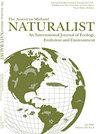Graminoid到灌木占主导地位的沼泽地上繁殖鸟类的发生率和火灾历史
IF 0.6
4区 环境科学与生态学
Q4 Agricultural and Biological Sciences
引用次数: 0
摘要
摘要草原和草灌木栖息地鸟类数量的减少已被确定为一个重要的保护问题。主要在高地系统中研究了木本植物入侵草原主导系统可能导致物种减少的影响。我们研究了密歇根上半岛以禾本科植物为主的湿地到灌木为主的湿地梯度上鸟类的出现情况,并描述了与它们在分段(100×100米)和景观(200米缓冲区)尺度上出现的概率相关的栖息地特征。由于火灾可以抑制木材的入侵,我们还研究了火灾历史对鸟类和栖息地特征的影响,从50年开始。我们重点研究了七个与草原和草灌木栖息地密切相关的物种,但也在湿地中发现:Sedge Wren(Asio flammeus)、LeConte’s Sparrow(Ammodramus leconteii)、Savannah Sparrow(Passerculus sandwichensis)、Bobolink(Dolichonyx oryzivorus)、Common Yellowthrought(Geothlypis trichas)、Swamp Sparrow(Melospiza georgiana)和Alder Flycatcher(Empidonax alnorum)。我们使用非参数乘法回归模型将栖息地变量和火灾历史与物种发生的概率联系起来。与在高地草原上进行的研究不同,没有一个顶级模型包括枯枝落叶或类禾本科高度的测量,而且发生的最高概率通常是类禾本科覆盖率处于中等而非最高水平的地方。木质覆盖层或结构的测量对所有七个建模物种都很重要。在燃烧的第一年之后,我们观察到不同火灾历史类别的栖息地指标几乎没有明显差异。尽管火灾历史类别中的栖息地指标变化很大,但自上次被烧毁以来的年份是七个物种中四个物种的最佳模型;这些物种更有可能出现在15-19年前被烧毁的部分。沼泽地罕见的轻度至中度火灾在燃烧后的第一年后对重点物种的发生几乎没有影响,对抑制木质覆盖的长期影响也很小。本文章由计算机程序翻译,如有差异,请以英文原文为准。
Breeding Bird Occurrence Across a Gradient of Graminoid- to Shrub-Dominated Fens and Fire Histories
Abstract. Population declines of birds affiliated with grasslands and grass-shrub habitats have been identified as a critical conservation concern. The effects of woody encroachment into grassland-dominated systems, which may contribute to species declines, has been examined mainly in upland systems. We examined occurrence of bird species across a gradient of graminoid- to shrub-dominated wetlands in the Upper Peninsula of Michigan and describe the habitat characteristics associated with their probability of occurrence at segment (100 × 100 m) and landscape (200 m buffer) scales. Because fire can suppress woody encroachment, we also examined the role of fire history, extending from <1 to >50 y on birds and habitat characteristics. We focused on seven species closely affiliated with grassland and grass-shrub habitats, but also found in wetlands: Sedge Wren (Asio flammeus), LeConte's Sparrow (Ammodramus leconteii), Savannah Sparrow (Passerculus sandwichensis), Bobolink (Dolichonyx oryzivorus), Common Yellowthroat (Geothlypis trichas), Swamp Sparrow (Melospiza georgiana), and Alder Flycatcher (Empidonax alnorum). We used nonparametric, multiplicative regression models to relate habitat variables and fire history to probability of species occurrence. Unlike studies in upland grasslands, none of the top models included measures of litter or graminoid height, and the highest probability of occurrence often was where graminoid cover was at intermediate rather than highest levels. Measures of woody cover or structure were important to all seven species modeled. We observed few clear differences in habitat metrics across fire history categories beyond the first year of burning. Years since last burned was in the best model for four of the seven species, despite high variability of habitat metrics within fire history categories; those species were more likely to occur in segments burned 15–19 y earlier. Infrequent light- to moderate-severity fires in fens had little effect on focal species occurrence beyond the first year after burning and little long-term effect to suppress woody cover.
求助全文
通过发布文献求助,成功后即可免费获取论文全文。
去求助
来源期刊

American Midland Naturalist
环境科学-生态学
CiteScore
1.20
自引率
0.00%
发文量
38
审稿时长
18-36 weeks
期刊介绍:
The American Midland Naturalist has been published for 90 years by the University of Notre Dame. The connotations of Midland and Naturalist have broadened and its geographic coverage now includes North America with occasional articles from other continents. The old image of naturalist has changed and the journal publishes what Charles Elton aptly termed "scientific natural history" including field and experimental biology. Its significance and breadth of coverage are evident in that the American Midland Naturalist is among the most frequently cited journals in publications on ecology, mammalogy, herpetology, ornithology, ichthyology, parasitology, aquatic and invertebrate biology and other biological disciplines.
 求助内容:
求助内容: 应助结果提醒方式:
应助结果提醒方式:


